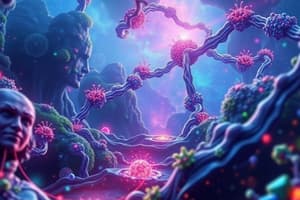Podcast
Questions and Answers
What is the primary function of a biological database?
What is the primary function of a biological database?
- To store, organize, and manage biological data (correct)
- To analyze patient genomic data for personalized medicine
- To identify potential drug targets for cancer treatment
- To perform sequence alignment and network visualization
What is the purpose of data preprocessing in biological databases?
What is the purpose of data preprocessing in biological databases?
- To visualize and compare DNA or protein sequences
- To combine and link data from various sources
- To clean, standardize, and format data for integration (correct)
- To analyze evolutionary relationships between species
What is the benefit of federated databases in biological databases?
What is the benefit of federated databases in biological databases?
- Seamless integration and interoperability between distributed databases (correct)
- Improved data security and access control
- Increased storage capacity for large-scale datasets
- Enhanced data visualization and analysis tools
What is the application of biological databases in evolutionary studies?
What is the application of biological databases in evolutionary studies?
What is the primary function of biological databases?
What is the primary function of biological databases?
What is the role of AI-driven curation in biological databases?
What is the role of AI-driven curation in biological databases?
What is the purpose of data annotation in biological databases?
What is the purpose of data annotation in biological databases?
Which type of database focuses on specific types of biological data, such as gene expression and disease-related information?
Which type of database focuses on specific types of biological data, such as gene expression and disease-related information?
What is the purpose of data integration in biological databases?
What is the purpose of data integration in biological databases?
What is the benefit of real-time data capture in biological databases?
What is the benefit of real-time data capture in biological databases?
Which step in the data curation process ensures the accuracy and integrity of the data?
Which step in the data curation process ensures the accuracy and integrity of the data?
What is the application of biological databases in drug discovery?
What is the application of biological databases in drug discovery?
What is the purpose of controlled vocabularies in biological databases?
What is the purpose of controlled vocabularies in biological databases?
What feature of biological databases allows users to explore and retrieve data?
What feature of biological databases allows users to explore and retrieve data?
What is the purpose of filtering and sorting options in biological databases?
What is the purpose of filtering and sorting options in biological databases?
What feature of biological databases allows users to access data programmatically?
What feature of biological databases allows users to access data programmatically?
What type of biological database provides tools for analyzing and visualizing data?
What type of biological database provides tools for analyzing and visualizing data?
Which of the following is a benefit of biological databases?
Which of the following is a benefit of biological databases?
What is the main purpose of data curation and annotation in biological databases?
What is the main purpose of data curation and annotation in biological databases?
Which biological database is an example of a specialized database?
Which biological database is an example of a specialized database?
What is the primary function of primary databases in biological databases?
What is the primary function of primary databases in biological databases?
Which of the following is a feature of biological databases that enables personalized medicine?
Which of the following is a feature of biological databases that enables personalized medicine?
What is the main advantage of secondary databases in biological databases?
What is the main advantage of secondary databases in biological databases?
Which biological database is an example of a database that stores protein sequences and structures?
Which biological database is an example of a database that stores protein sequences and structures?
What is the primary challenge in integrating biological data from various sources?
What is the primary challenge in integrating biological data from various sources?
Which database is a comprehensive index of biomedical literature?
Which database is a comprehensive index of biomedical literature?
What is the name of the database that houses protein sequences from various sources?
What is the name of the database that houses protein sequences from various sources?
What is the main goal of ensuring data quality control in biological databases?
What is the main goal of ensuring data quality control in biological databases?
Which of the following is NOT one of the key databases within NCBI?
Which of the following is NOT one of the key databases within NCBI?
What is a key aspect of research at EMBL?
What is a key aspect of research at EMBL?
Why are biological databases essential resources for modern biological research?
Why are biological databases essential resources for modern biological research?
What is the name of the organization that manages the NCBI database?
What is the name of the organization that manages the NCBI database?
Which of the following databases is primarily focused on the relationship between genetic variations and their clinical significance?
Which of the following databases is primarily focused on the relationship between genetic variations and their clinical significance?
What type of data can be found in the Structure database?
What type of data can be found in the Structure database?
Which of the following is NOT a research area at EMBL?
Which of the following is NOT a research area at EMBL?
What is the primary role of the Taxonomy database?
What is the primary role of the Taxonomy database?
Which of the following is a characteristic of EMBL's research environment?
Which of the following is a characteristic of EMBL's research environment?
What is the name of the organization that encompasses the Genome, Taxonomy, and ClinVar databases?
What is the name of the organization that encompasses the Genome, Taxonomy, and ClinVar databases?
Study Notes
Introduction to Biological Databases
- Biological databases are vast digital repositories that store and organize a wide range of biological data, including DNA sequences, protein structures, gene expression profiles, and other molecular information.
Types of Biological Databases
- Nucleotide Databases: Store and manage DNA and RNA sequence data, such as GenBank, EMBL, and DDBJ.
- Protein Databases: Contain information on protein sequences, structures, and functions, including UniProt and the Protein Data Bank (PDB).
- Specialized Databases: Focus on specific types of biological data, such as gene expression, pathways, and disease-related information.
Data Curation and Annotation
- Data Submission: Researchers submit their data to curated databases for storage and sharing.
- Annotation: Databases add metadata, such as descriptive labels and cross-references, to enhance the data's utility.
- Quality Control: Databases implement rigorous processes to ensure the accuracy and integrity of the data.
- Controlled Vocabularies: Standardized terms and ontologies are used to facilitate data integration and retrieval.
Database Search and Retrieval
- Query Interfaces: Intuitive search tools allow users to explore and retrieve data from databases.
- Filtering and Sorting: Powerful filtering and sorting options help users navigate and refine their searches.
- Data Downloading and API Access: Users can download relevant data in various formats and access databases programmatically through APIs.
Integrating Biological Data
- Data Sources: Diverse data from various biological databases and experimental sources.
- Data Preprocessing: Cleaning, standardizing, and formatting the data for integration.
- Data Integration: Combining and linking the data to create a comprehensive and interoperable resource.
- Visualization and Analysis Tools: Tools for analyzing and visualizing data, such as sequence alignment, structural viewers, and network visualization.
Applications of Biological Databases
- Drug Discovery: Identify potential drug targets and test candidate compounds using database information.
- Personalized Medicine: Analyze patient genomic data to guide tailored treatments and interventions.
- Evolutionary Studies: Trace the evolutionary relationships and histories of species using sequence data.
- Biodiversity Conservation: Catalog and monitor the diversity of life on Earth using database resources.
Future Trends in Biological Databases
- AI-Driven Curation: Automated machine learning techniques to enhance data annotation and quality control.
- Federated Databases: Seamless integration and interoperability between distributed and heterogeneous databases.
- Real-Time Data Capture: Sensors and IoT devices enabling the continuous and rapid collection of biological data.
Studying That Suits You
Use AI to generate personalized quizzes and flashcards to suit your learning preferences.
Related Documents
Description
This quiz covers the basics of biological databases, including types of databases, storing and managing DNA sequences, protein structures, and other molecular data.




